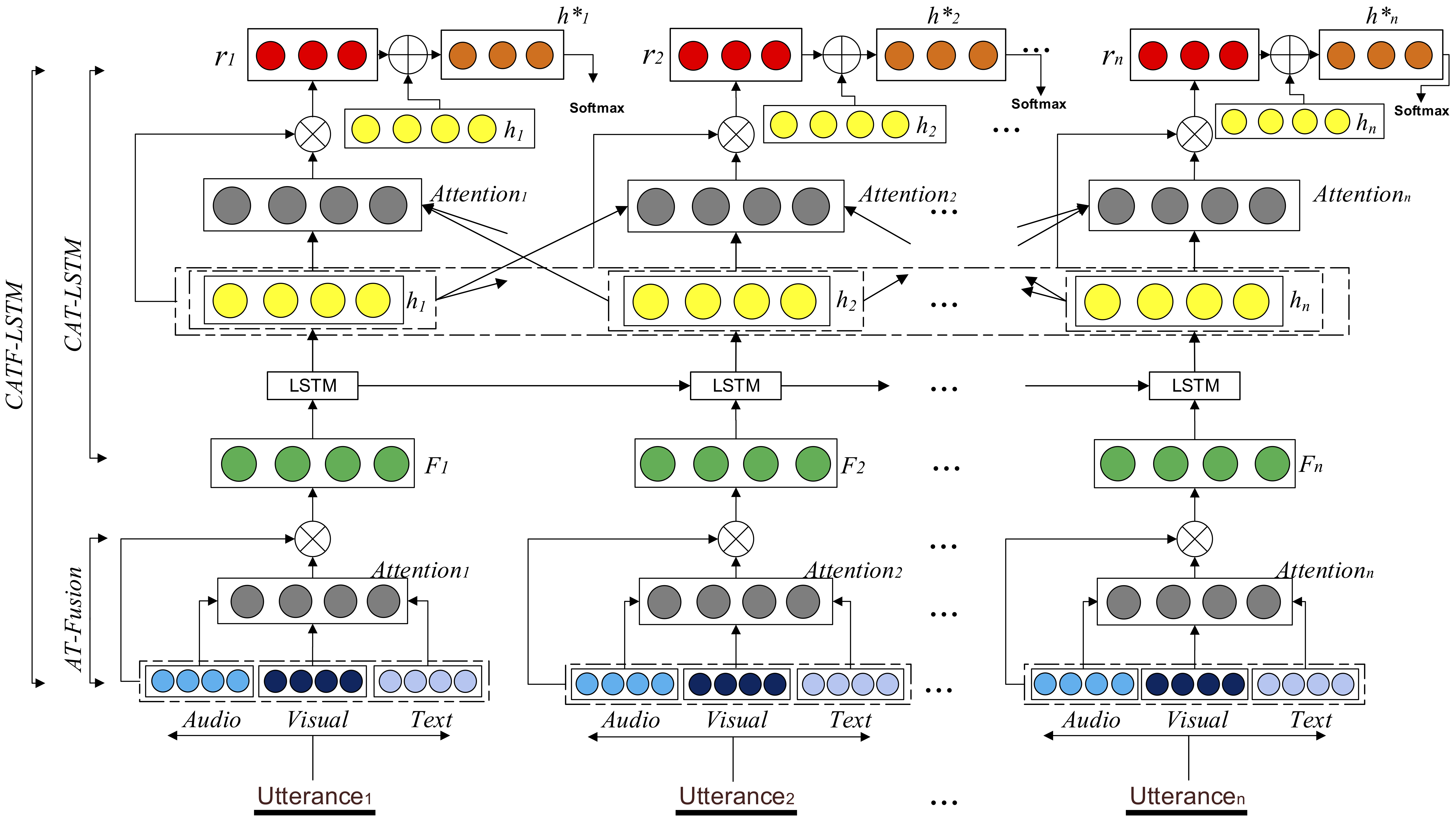soujanyaporia / Multimodal Sentiment Analysis
Programming Languages
Labels
Projects that are alternatives of or similar to Multimodal Sentiment Analysis
Attention-based multimodal fusion for sentiment analysis
Attention-based multimodal fusion for sentiment analysis
Code for the paper
Context-Dependent Sentiment Analysis in User-Generated Videos (ACL 2017).
Multi-level Multiple Attentions for Contextual Multimodal Sentiment Analysis(ICDM 2017).
Preprocessing
Edit: the create_data.py is obsolete. The pre-processed datasets have already been provided in the dataset/ folder in the repo. Use them directly.
As data is typically present in utterance format, we combine all the utterances belonging to a video using the following code
python create_data.py
Note: This will create speaker independent train and test splits In dataset/mosei, extract the zip into a folder named 'raw'. Also, extract 'unimodal_mosei_3way.pickle.zip'
Running the model
Sample command:
With attention-based fusion:
python run.py --unimodal True --fusion True
python run.py --unimodal False --fusion True
Without attention-based and with concatenation-based fusion:
python run.py --unimodal True --fusion False
python run.py --unimodal False --fusion False
Utterance level attention:
python run.py --unimodal False --fusion True --attention_2 True
python run.py --unimodal False --fusion True --attention_2 True
Note:
- Keeping the unimodal flag as True (default False) shall train all unimodal lstms first (level 1 of the network mentioned in the paper)
- Setting --fusion True applies only to multimodal network.
Datasets:
We provide results on the MOSI, MOSEI and IEMOCAP datasets.
Please cite the creators.
We are adding more datasets, stay tuned.
Use --data [mosi|mosei|iemocap] and --classes [2|3|6] in the above commands to test different configurations on different datasets.
mosi: 2 classes
mosei: 3 classes
iemocap: 6 classes
Example:
python run.py --unimodal False --fusion True --attention_2 True --data mosei --classes 3
Dataset details
MOSI:
2 classes: Positive/Negative
Raw Features: (Pickle files)
Audio: dataset/mosi/raw/audio_2way.pickle
Text: dataset/mosi/raw/text_2way.pickle
Video: dataset/mosi/raw/video_2way.pickle
Each file contains:
train_data, train_label, test_data, test_label, maxlen, train_length, test_length
train_data - np.array of dim (62, 63, feature_dim)
train_label - np.array of dim (62, 63, 2)
test_data - np.array of dim (31, 63, feature_dim)
test_label - np.array of dim (31, 63, 2)
maxlen - max utterance length int of value 63
train_length - utterance length of each video in train data.
test_length - utterance length of each video in test data.
Train/Test split: 62/31 videos. Each video has utterances. The videos are padded to 63 utterances.
IEMOCAP:
6 classes: happy/sad/neutral/angry/excited/frustrated
Raw Features: dataset/iemocap/raw/IEMOCAP_features_raw.pkl (Pickle files)
The file contains:
videoIDs[vid] = List of utterance IDs in this video in the order of occurance
videoSpeakers[vid] = List of speaker turns. e.g. [M, M, F, M, F]. here M = Male, F = Female
videoText[vid] = List of textual features for each utterance in video vid.
videoAudio[vid] = List of audio features for each utterance in video vid.
videoVisual[vid] = List of visual features for each utterance in video vid.
videoLabels[vid] = List of label indices for each utterance in video vid.
videoSentence[vid] = List of sentences for each utterance in video vid.
trainVid = List of videos (videos IDs) in train set.
testVid = List of videos (videos IDs) in test set.
Refer to the file dataset/iemocap/raw/loadIEMOCAP.py for more information. We use this data to create a speaker independent train and test splits in the format. (videos x utterances x features)
Train/Test split: 120/31 videos. Each video has utterances. The videos are padded to 110 utterances.
MOSEI:
3 classes: positive/negative/neutral
Raw Features: (Pickle files)
Audio: dataset/mosei/raw/audio_3way.pickle
Text: dataset/mosei/raw/text_3way.pickle
Video: dataset/mosei/raw/video_3way.pickle
The file contains: train_data, train_label, test_data, test_label, maxlen, train_length, test_length
train_data - np.array of dim (2250, 98, feature_dim)
train_label - np.array of dim (62, 63, 2)
test_data - np.array of dim (31, 63, feature_dim)
test_label - np.array of dim (31, 63, 2)
maxlen - max utterance length int of value 98
train_length - utterance length of each video in train data.
test_length - utterance length of each video in test data.
Train/Test split: 2250/678 videos. Each video has utterances. The videos are padded to 98 utterances.
Citation
If using this code, please cite our work using :
@inproceedings{soujanyaacl17,
title={Context-dependent sentiment analysis in user-generated videos},
author={Poria, Soujanya and Cambria, Erik and Hazarika, Devamanyu and Mazumder, Navonil and Zadeh, Amir and Morency, Louis-Philippe},
booktitle={Association for Computational Linguistics},
year={2017}
}
@inproceedings{poriaicdm17,
author={S. Poria and E. Cambria and D. Hazarika and N. Mazumder and A. Zadeh and L. P. Morency},
booktitle={2017 IEEE International Conference on Data Mining (ICDM)},
title={Multi-level Multiple Attentions for Contextual Multimodal Sentiment Analysis},
year={2017},
pages={1033-1038},
keywords={data mining;feature extraction;image classification;image fusion;learning (artificial intelligence);sentiment analysis;attention-based networks;context learning;contextual information;contextual multimodal sentiment;dynamic feature fusion;multilevel multiple attentions;multimodal sentiment analysis;recurrent model;utterances;videos;Context modeling;Feature extraction;Fuses;Sentiment analysis;Social network services;Videos;Visualization},
doi={10.1109/ICDM.2017.134},
month={Nov},}
Credits
Gangeshwar Krishnamurthy ([email protected]; Github: @gangeshwark)

